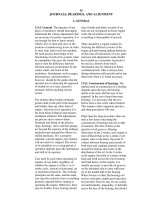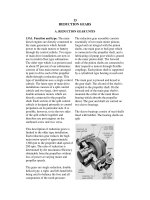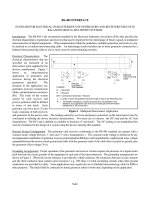Tài liệu Warming Climate change pptx
Bạn đang xem bản rút gọn của tài liệu. Xem và tải ngay bản đầy đủ của tài liệu tại đây (1.04 MB, 20 trang )
Warmi ng
Climate change – the facts
Climate change
is a very real and
urgent global issue.
Its consequences
are being
experienced every
day. We read about
it in newspapers,
hear it debated
in Parliament and
our children learn
about it in school.
It’s a problem we
all share, because
every single
country will be
affected. Together,
today, we must
take action to adapt
to it and stop it —
or, at least, slow it
down.
Climate change –
your essential guide
It’s now clear that the
emission of man-made
greenhouse gases
is causing climate
change. The rate of
change began as
significant, has become
alarming and is simply
unsustainable in the
long-term.
We’re causing it.
So let’s do something about it.
This guide tells you everything you need
to know about climate change and,
importantly, what it means for you and what
you can do about it.
It answers four questions:
• What is climate change?
• What does it mean for the world?
• What are the misconceptions?
• What can I do now?
What is climate change? 01
What is climate change?
The Earth’s climate has changed many times in response
to natural causes. The term climate change usually refers
to man-made changes that have occurred since the early
1900s.
What is the difference between weather
and climate?
To understand climate change, it’s important to
recognise the difference between weather and climate.
Weather is the temperature, precipitation (rain, hail,
sleet and snow) and wind, which change hour by hour
and day by day. Climate is the average weather and the
nature of its variations that we experience over time.
1. Sunlight passes through
the atmosphere and
warms the Earth.
3. But some IR is trapped
by gases in the air and
this reduces the
cooling effect.
2. Infrared Radiation (IR) is
given off by the Earth.
Most IR escapes to outer
space and cools the Earth.
What is the greenhouse effect?
The greenhouse effect is the natural process of the
atmosphere letting in some of the energy we receive
from the Sun (ultraviolet and visible light) and stopping it
being transmitted back out into space (infrared radiation
or heat). This makes the Earth warm enough for life.
For several thousands of years the atmosphere has been
delicately balanced, with levels of greenhouse gases
relatively stable. Human inuence has now upset that
balance and, as a result, we are seeing climate change.
Even if global
temperatures rise
by only 2
o
C,
20-30% of species
could face
extinction.
What is climate change? 01
The greenhouse effect.
What will happen if we don’t act to
reduce emissions?
If we don’t stop, or at least reduce,
these harmful emissions, the levels of
greenhouse gases in the atmosphere are
predicted to double from pre-industrial
levels by 2050. This is very likely to
commit the Earth to an eventual global
temperature rise of 1.8–6.4 °C and push
many of its great ecosystems (such as
coral reefs and rainforests) to irreversible
decline.
Even if global temperatures rise by only
2 °C, 20–30% of species could face
extinction; while we can expect to see
serious effects on our environment, food
and water supplies, and health.
02 What is climate change?
How are we causing climate change?
An increase in the greenhouse gases in
the atmosphere, from human activities
like burning coal, oil and gas, has led to
an enhanced greenhouse effect and extra
warming. As a result, over the past century
there has been an underlying increase in
average temperatures which continues.
The ten hottest years on record globally
have all been since 1997.
Which gases are causing the
most change?
The main greenhouse gas responsible
for recent climate change is CO
2
. This
has been released in huge quantities
by our modern way of life. Levels have
also increased due to the destruction of
rainforests, which play an important role
in absorbing CO
2
.
Human activities are increasing other
greenhouse gases too, such as methane
and nitrous oxide. Methane is produced
by bacteria that live in places like landll
sites, peat bogs and in the guts of animals
like cows and sheep. Nitrous oxide is
increased by the use of nitrogen fertiliser
in agriculture.
Both these gases have a powerful
greenhouse effect and also contribute to
climate change. However, they have not
been released in such large quantities
as CO
2
and methane does not last for as
long in the atmosphere. So, while they
make a signicant contribution to climate
change, it is man-made CO
2
which has by
far the greatest inuence.
Why are sea levels rising?
There are two ways in which a warming climate raises sea levels:
Thermal expansion — as water warms it expands, like liquid in a thermometer.
As the oceans are heated by the warming climate sea-levels will rise.
Ice-melt — large amounts of water are locked in glaciers, permafrost and ice-caps
around the world. Warmer weather is causing these to melt. Water from land-
based ice will ow into the oceans, raising sea levels. Sea levels around the UK have
already risen by 10 cm since 1900 and scientists are still researching how quickly
they will continue to rise.
What is climate change? 03
1.
2.
Will it get hotter everywhere?
Yes. Even if the concentrations of greenhouse
gases and aerosols stabilised at the year 2000
levels then we would still expect temperatures
to reach 1.3 °C above pre-industrial levels by
2100 (Source: IPCC).
Even if emissions peak in 2015 and decrease
rapidly at 3% every year after that, there’s
around only a 50:50 chance of keeping global
temperature rise below 2 °C.
Every delay of ten years in the peak emissions
would add about 0.5 °C of warming.
Which areas are warming most?
In recent decades the Arctic has been heating
twice as fast as the rest of the world, largely
because Arctic ice, which reects sunlight
and keeps the surface cool, has decreased. In
particular, summer Arctic sea-ice has shrunk by
about 20% in the last 30 years. Land-ice and
snow-cover have also decreased — a bigger
effect in the short-term because land heats up
more quickly than the sea.
The Northern Hemisphere is warming more
than the Southern Hemisphere. This is because
the Northern Hemisphere has more land mass,
which heats more quickly than water.
Map showing how the world will warm
by early, mid and late 21st century for a
medium-high emissions scenario.
IPCC 2007
What does it mean for the world?
Climate change will mean warmer temperatures which will affect rainfall patterns, cause
snow and ice to melt and affect the intensity of extreme weather such as storms and
heatwaves. We have already begun to experience some of these impacts and many other
knock-on effects:
04 What does it mean for the world?
Past records and future projections (medium-high emissions scenario) of Earth’s
surface temperature change.
Water
& Food
Health
Environment
Ecosystems
Met Ofce prediction
Range of temperatures from natural records (e.g. ice cores)
Temperatures observed
What does it mean for the world? 05
Our well-being will be
threatened by more frequent
and intense heatwaves, floods,
storms, wildfires and droughts
around the world.
Amazonia, if not already deforested by human activity, may
become too dry to support the rainforest and at increased risk from
re. Other precious areas of high biodiversity, such as in South Africa,
may see major losses of species as habitat conditions change. Around
the world, some animals and plants may benet and ourish in a
changing climate, while others are likely to suffer.
Between 1.4 and 2.1 billion people currently live in water-
stressed regions. Climate change and population growth
could increase this to 2 billion by the 2050s, intensifying
competition for this life-giving resource. Some areas could
become more fertile; others more barren. This may lead
to regional food shortages, mass migration and poverty.
Malnutrition is expected to increase in developing countries
(Source: IPCC 2007).
Our well-being will be threatened by more frequent and
intense heatwaves, oods, storms, wildres and droughts.
However, deaths from cold-related diseases will reduce.
Patterns of disease will also change, with wide areas of the
world becoming at risk from major diseases, such as Dengue.
Coastal areas will experience more ooding from rising
sea-levels, especially large river deltas which tend to be
highly populated e.g. the Nile Delta. Meanwhile, some
areas will attract more tourism as their climates modify.
How our climate has changed
Central England temperatures have •
increased by 1 °C since 1970s.
Total summer rainfall has decreased in •
most parts of the UK.
Sea-surface temperature around the •
UK has risen by about 0.7 °C over the
past three decades.
The UK has experienced eight of the •
10 warmest years on record since
1990.
Sea levels around the UK have risen •
10 cm since 1900.
What about the UK?
Even across relatively small areas like
the UK, climate change is expected to
cause marked regional differences in
temperature and rainfall by the end of
the 21st century:
06 What does it mean for the world?









